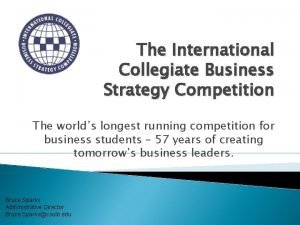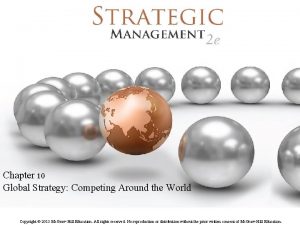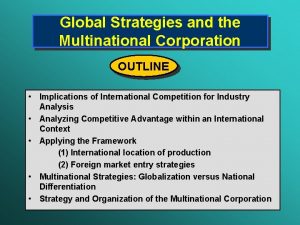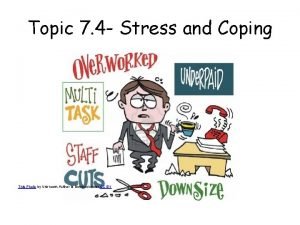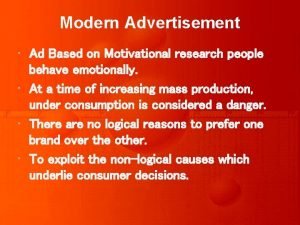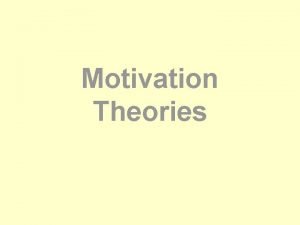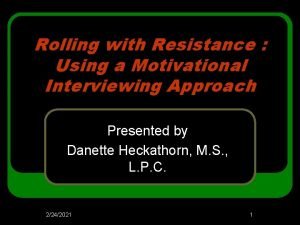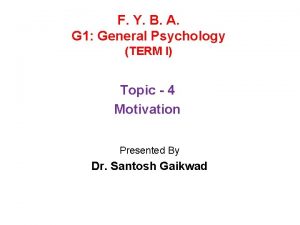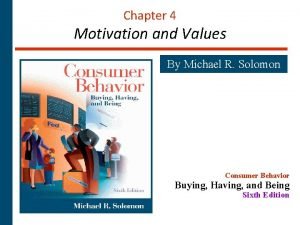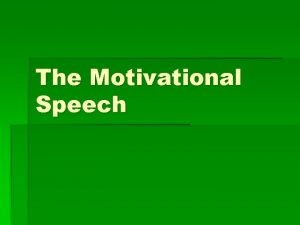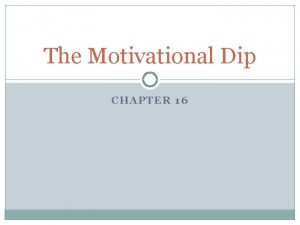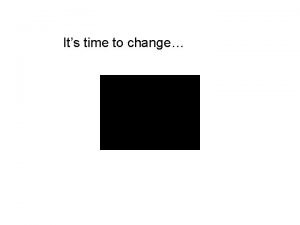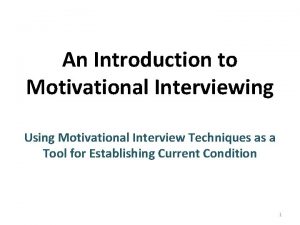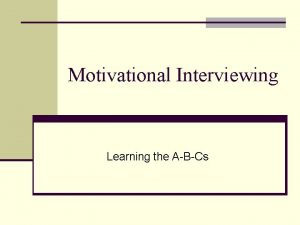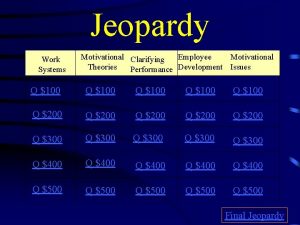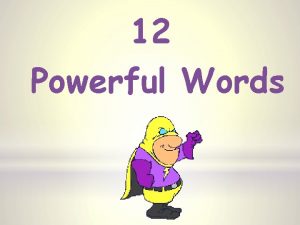Competition Is Competition l A powerful motivational strategy









































- Slides: 41

Competition

Is Competition … l. A powerful motivational strategy? l An effective quality control device? l A way to develop positive character traits? l A fair process that ensures that the best team normally wins? l Good? l America is a highly cooperative society. Discussion Question 1: Is Competition Good?

Reward Definitions l Competition: A situation in which rewards are distributed unequally on the basis of performance by the performers. l Cooperation: A social process through which performance is evaluated and rewarded in terms of the collective achievements of a group of people working together to reach a particular goal.

Problems w/ Reward Definitions l For every winner, there has to be one or more losers. l Does not account for differences in individual reactions to competition. l Assumes the ‘reward’ to be the same for every competitor. l Intrinsic vs. extrinsic rewards DQ 2: List 3 examples of intrinsic & extrinsic rewards from sport?

Problems w/ Reward Definitions l Differences between competition and cooperation are emphasized, rather than their similarities. l You have to cooperate in order to compete. l Competition requires both within-team and between-team cooperation. DQ 3: List 3 examples of between-team cooperation?

Competition and Cooperation As Complimentary l Competition and cooperation are not polar opposites. l The dynamics of how competition and cooperation complement one another should be taught. l Top performers employ a blend of competition and cooperation strategies.

Competition vs. Cooperation Cooperative activities produce more open communication, sharing, trust, friendship, and enhanced performance compared with competitive activities. l Johnson & Johnson (1985) l l Review of 122 studies l Cooperation improved performance more than competition in 65 studies (8 showed opposite effects). l Cooperation improved performance more than individual efforts in 108 studies (6 showed opposite effects). l Questionable tasks and contests however.

Problems Associated with Competition l ‘Win-at-all-costs’ mentality. l Promotes youth sport dropout. l Reduces motivation for those that remain involved. l Reduces enjoyment for ‘unsuccessful’ competitors. l Facilitates a short-term focus only.

Competition as a Process l Martens’ Process Model l 4 stages to the competitive process. l Explains why people respond differently to competition. l Social comparison process.

Stage #1: Objective Competitive Situation l Four objective criteria that must be present in order to conclude that competition is occurring. 1. A standard of comparison is identified for the team or individual. l 2. Another person is present. l 3. This person knows the standard. l 4. This person evaluates whether the standard has been obtained. l l What are the advantages / disadvantages of the Objective Competitive Situation (OCS)?

Stage #2: Subjective Competitive Situation l How an athlete perceives, accepts, and appraises the OCS. l SCS is affected by personality traits, perceived importance of competition, perception of the comparison standard, and perceived response capabilities. l As a result, athletes seek out competition, enter it reluctantly, or attempt to avoid it.

Stage #3: Response l After the appraisal of the OCS, athletes experience positive and negative adaptations, preparing them for competition. l Physiologically l Psychologically l Behaviorally

Stage #4: Consequences l Athletes’ perception of consequence (e. g. , success or failure) is more important than the actual outcome. l Athletes perceive positive or negative consequences as a result of participation. l These consequences impact: l Short and long term emotions. l Perceptions of competence. l Future decisions to compete.

Variable Factors in OCS l Social Environment l Presence of others: l Who? l How many? l Audience or co-actors? l Attributes l Ability. l Age. l Sex. of opponents:

Variable Factors in OCS l Physical Environment l Playing field conditions. l Weather. l Rewards l Tangible. l Intangible. l Task Characteristics l Performance demands. l Rules of contest.

Martens’ Motto l “Athletes first, winning second” l To broaden Martens’ earlier motto, a revised motto, “Personal excellence. The foundation for success” highlights the relationship shared between personal development and success.

Bringing the Motto to Life l ‘Striving to win’ vs. ‘Actually winning’. l Appreciating ‘the journey’ vs. ‘the destination’. l The challenge becomes practicing what you preach. l Community-wide philosophy development.

Motivation and Competition High Anxiety Level of Challenge Boredom Low Athletes’ Skill Level High

Myths of Competition l Myth 1: Competition is a powerful motivational strategy. l Truth: Competition provides the greatest motivation when the level of challenge is moderately difficult and matches the current capabilities of the athlete.

Myths of Competition l Myth 2: Competition is an effective quality control strategy. l Truth: Competition leads to shortsightedness, and athletes sacrifice long -term improvement and learning in order to achieve short-term success.

Myths of Competition l Myth 3: Competition develops positive character traits. l Truth: Winning can be a double-edge sword for teaching character development.

Myths of Competition l Myth 4: Competition is a fair process that insures that the best team normally wins. l Truth: The playing field is rarely level, and even when it is, winning is very uncontrollable and often pursued via unfair methods.

Association Model of Competition Cooperative games Frisbee Assembly lines Sport Noncompetitive Competitive Hermit War with no rules Noncooperative

Competition: Good or Bad? l Competition is neither good nor bad. Rather, it is simply a neutral process and depends on the athletes’ appraisal of the OCS, response, and perception of consequences.

Taking a Hint from Recess l Coakly (1997) l Unorganized games result in increased cooperation, decision making, creativity, and action… things that rule-centered organized sport stifles. l Coaches, teachers, and sport directors should take a hint from the behaviors of children when games are spontaneous.

Taking a Hint from Recess l Coakly (1997) l Unorganized sport behaviors: Kids modify games to maximize cooperation, success, and enjoyment. l Increased action and scoring opportunities. l More constant involvement during the game. l Closely-matched teams. l Friendship development and maintenance.

Competitive Engineering l The competitive engineering process l Modifying the structure, rules, facilities, and equipment of a particular sport to enhance athletes’ competitive experience. l Benefits include enhanced skill development, improved enjoyment, better competitive balance, and reduced attrition.

Competitive Engineering: Basic Premises 1. Increased action and scoring will make sport more enjoyable. -- Equipment and rule modifications. 2. Create high levels of personal involvement. -- Increase playing time and opportunities to play ‘glamour’ positions. 3. Keep scores close to maximize interest, enjoyment, and motivation. -- Equalize talent across teams.

Competitive Engineering: Basic Premises 4. Competition should promote positive relationships between all participants. -- Utilize joint practices, socialization rules, and social events. 5. Use multiple-level program and pyramid-based community models to better meet the needs of a diverse group of athletes.

Pyramid-Based Model V: Regional Travel Team IV: Local Travel Team III: Competitive Leagues II: Recreational Program I: Instructional Program

Examples of Competitive Engineering: Basketball l Facilities Smaller courts. l Shorter free throw line. l Shorter 3 point line. l Lower basket. l Bigger goal. l l Equipment Smaller ball. l Colored wrist bands to help players know who they are guarding. l

Examples of Competitive Engineering: Basketball l Rules Playing time rules. l Position rotation rules. l Limitations on when pressing is allowed. l No zone defense. l Limit timeouts. l Place a cap on the number of points 1 player is allowed to score. l Catch-up rules: l l Use press entire time, keep possession following a score, opponent must sit top player.

Examples of Competitive Engineering: Baseball l Facilities Shorter bases. l Shorter fences. l Lower fences. l Closer pitching rubber. l l Equipment Batting tee or pitching machine. l Softer balls. l Helmets with face masks. l Bat modifications: barrel size, weight. l

Examples of Competitive Engineering: Baseball l Rules Playing time rules. l Position rotation rules. l Modification to ball and strike limits. l Pitching machine and tee combinations. l Place a cap on runs scored each inning. l Everyone bats. l Innings pitched limitations. l Catch-up rules: l l 4 outs per inning, raise the run / inning limit.

Examples of Competitive Engineering: Flag Football l Facilities l Smaller fields. l Lower goal posts. l 10 yard 1 st down markers and chains. l Equipment l Smaller ball. l Velcro flags on both streamers and belts.

Examples of Competitive Engineering: Flag Football l Rules Playing time rules. Position rotation rules. Limit timeouts. All players are eligible receivers. Screen blocking only. Cap scoring by 1 individual player. Limit rough contact on defense by calling fouls. Modify downs and distance requirements. Slow the defensive rush by requiring a waiting period. l Catch-up rules: l l l l l Maintain possession when score, remove rush limitations.

Examples of Competitive Engineering: Soccer l Facilities l Smaller fields. l Larger goals. l Equipment l Softer ball. l Shin guards required.

l Rules l l l l l Examples of Competitive Engineering: Soccer Playing time rules. Position rotation rules. Limit timeouts. Free kicks instead of throw-ins. Remove goalie. Modify offsides rules and hand ball rules. Cap the number of goals allowed by 1 player. Modify placement of ball on corner kicks. No penalty kicks. Catch-up rules: l Maintain possession when score, sub out the leading teams’ two top players.

Competitive Philosophy l Your competitive philosophy guides your everyday actions and helps you to make the right decision for you by deciding what’s important ahead of time.

Developing Your Competitive Philosophy l 1. Self-awareness l Monitor thoughts, feelings, and behaviors. l Ask others. l 2. Prioritize competitive objectives l Personal l How development versus winning. much importance do you place on each of those objectives?

John Wooden’s Competitive Philosophy l Go to http: //www. coachjohnwooden. com/ l Find his pyramid of success. DQ 4: Which building blocks that Wooden uses do you disagree with or would have put them in a different order?
 Summarize reading
Summarize reading Monopoly vs monopolistic competition
Monopoly vs monopolistic competition Pure competition vs monopolistic competition venn diagram
Pure competition vs monopolistic competition venn diagram Competition refers to
Competition refers to Lump sum subsidy
Lump sum subsidy International collegiate business strategy competition
International collegiate business strategy competition Horizontal strategy and multipoint competition
Horizontal strategy and multipoint competition Chase demand strategy example
Chase demand strategy example The managerial process of crafting and executing strategy
The managerial process of crafting and executing strategy International strategy example
International strategy example Bottom-up listening strategies examples
Bottom-up listening strategies examples Strategy formation
Strategy formation Corporate strategy and business strategy
Corporate strategy and business strategy Aligning hr strategy with business strategy
Aligning hr strategy with business strategy Directional strategy in strategic management
Directional strategy in strategic management Multi domestic strategy
Multi domestic strategy Integration responsiveness grid
Integration responsiveness grid Multinational strategy vs global strategy
Multinational strategy vs global strategy Kurt lewin's motivational conflict theory
Kurt lewin's motivational conflict theory Motivational advertisement
Motivational advertisement Darn cat motivational interviewing
Darn cat motivational interviewing Mayo's motivation theory
Mayo's motivation theory Darn cat motivational interviewing
Darn cat motivational interviewing Motivational interviewing
Motivational interviewing Examples of rolling with resistance
Examples of rolling with resistance Motivational interviewing
Motivational interviewing Nnn motivational speech
Nnn motivational speech Motivational intervieuwing
Motivational intervieuwing Motivational cycle
Motivational cycle Motivational interviewing wiki
Motivational interviewing wiki 4 types of motivational conflict
4 types of motivational conflict Motivational interviewing
Motivational interviewing Motivational interviewing basics
Motivational interviewing basics Motivational presentation definition
Motivational presentation definition Darn cats motivational interviewing
Darn cats motivational interviewing Mi readiness ruler
Mi readiness ruler Motivational dip
Motivational dip Motivation is defined as
Motivation is defined as Desire ability reason need
Desire ability reason need Jeremy wampler
Jeremy wampler Contoh motivational interviewing
Contoh motivational interviewing Agreement with a twist motivational interviewing
Agreement with a twist motivational interviewing





